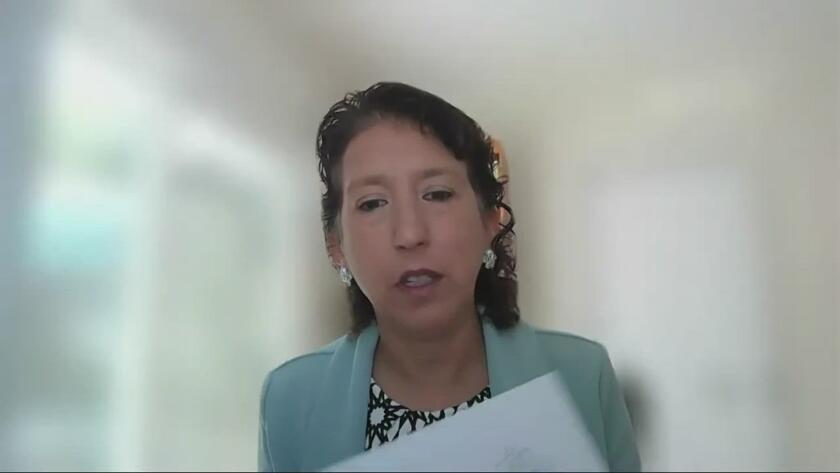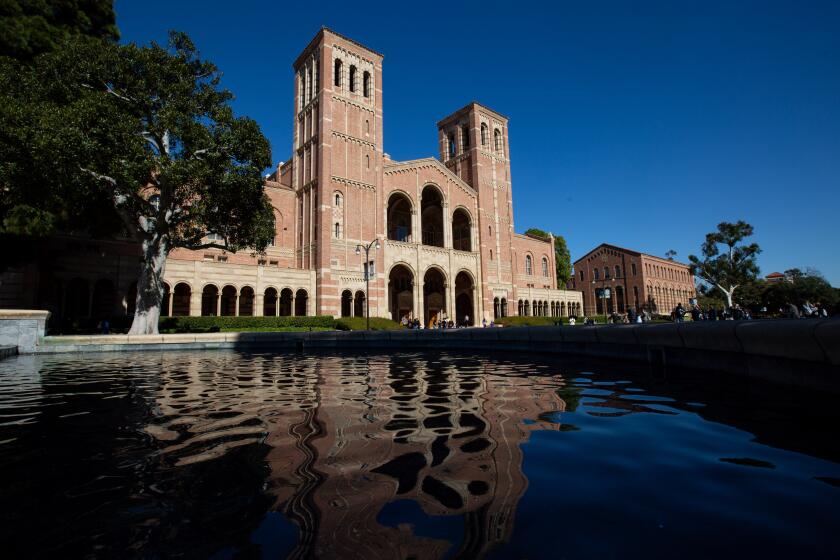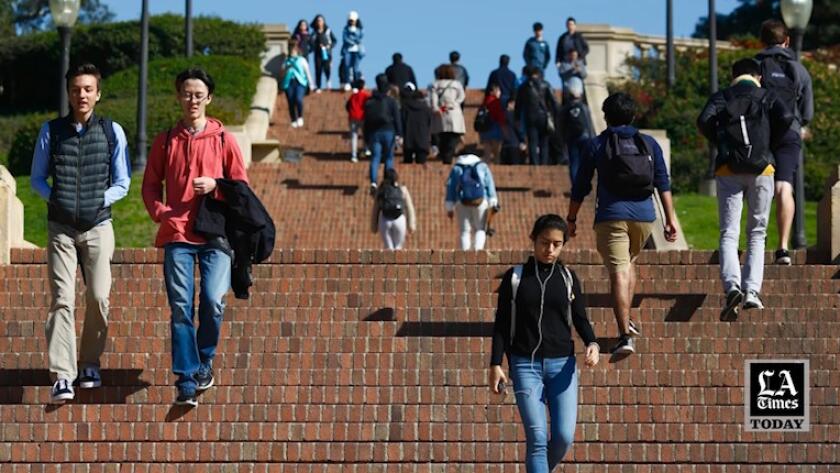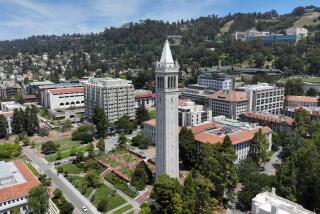California is failing to meet demand for UC admission. Why it’s a crisis
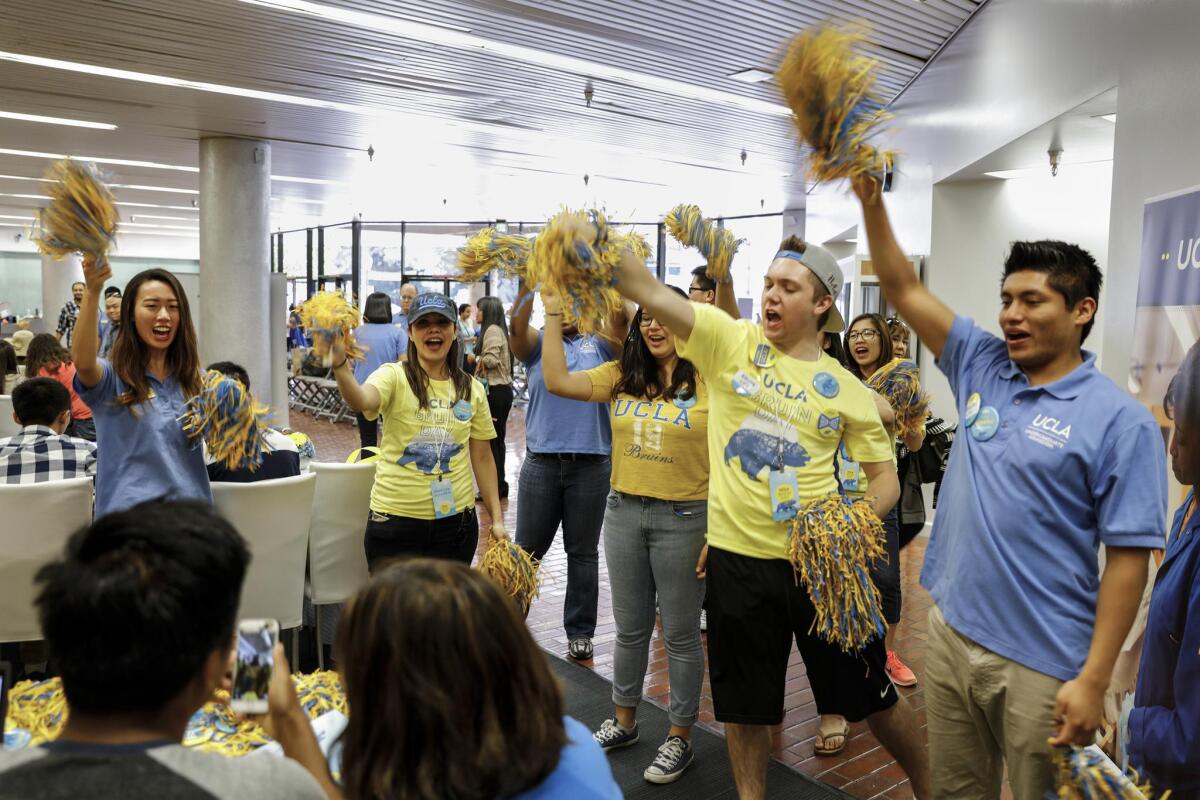
- Share via
A troubling undercurrent belies the University of California’s celebratory news that it has admitted the largest and most diverse class ever for fall 2021: There are not enough seats for qualified students at most campuses, a worsening capacity crisis that threatens to break the California promise of a UC education for them.
The space crunch is projected to intensify in the coming years just as the state needs more skilled talent, prompting the new UC Board of Regents chair to announce last week that increasing student enrollment would be one of the board’s top priorities.
UC admitted 132,353 freshman applicants for this fall, an 11% increase over last year. But it was harder to get in at seven of the nine undergraduate campuses compared with last year. More than 71,000 freshman applicants were denied admission, including nearly 44,000 Californians, the overwhelming majority of them eligible for UC admission if past trends are a guide.
The admission rates for California freshman applicants fell to a systemwide average of 65.7%, compared with 70.5% last year and, over a longer horizon, 83.5% in 1995.
The future is even more troubling.
The number of students who meet UC and California State University admission requirements but can’t enroll in a four-year institution because of a shortfall of seats could nearly double from about 73,000 students in 2018-19 to 144,000 by 2030, according to a study by the College Futures Foundation. The study, which found the biggest shortfalls in the Los Angeles region, Inland Empire and Central Valley, did not break down the future shortage of seats by university system.
As the capacity crunch devastates thousands of hard-working students and frustrates their tax-paying parents, the question of how to create more room at both UC and Cal State schools has taken on new urgency. Universities are looking at satellite locations, more online learning and faster graduation to open more seats even at campuses with little physical room for more students.
UC prioritizes expansion
In her first remarks as UC board chair last week, Regent Cecilia V. Estolano said she will push for enrollment expansion to be among the top three board priorities as current limits deprive too many of the transformative power of a UC degree.
“The moment that we’re in requires us to extend access to this world-class education,” Estolano said. “We need a thoughtful, bold but comprehensive plan that’s going to meet the needs of the world’s greatest state. We need a real course of action — and then we need to actually take that action.”
- Share via
In her first remarks as UC board chair last week, Regent Cecilia Estolano said she will push for enrollment expansion to be among the top three board priorities
In an interview with The Times, Estolano said she wanted to put “everything on the table,” including potential “educational hubs” where UC could possibly share facilities, coursework and even faculty with higher education partners. “The need is now,” she said.
Cecilia V. Estolano says expanding enrollment is a priority — to give more students a high-value degree and to provide the skilled talent California needs.
Legislators have pledged the largest single-year infusion of state funds to expand UC and CSU enrollment by more than 15,000 seats in fall 2022 and created a $2-billion fund for more student housing and facilities. They say the public university systems need to add more seats quickly to help the state provide the 1.1 million more college graduates required by 2030 for the fast-growing sectors of computer and mathematical sciences, business and financial operations and healthcare, as projected by the the Public Policy Institute of California and College Futures Foundation.
“I think the Legislature, particularly with UC, feels like there is a crisis in access,” said Sen. John Laird (D-Santa Cruz). “Every member, at every town hall, they hear from their constituents about some kid in their neighborhood who has like a 4.5 and can’t get into Berkeley or UCLA. It’s just like: ‘What is going on?’”
A ‘stunning’ shortfall
Monica Lozano, the College Futures Foundation president and former UC Board of Regents chair, called the looming shortfall “stunning” and said higher education needs to think in new ways. Her foundation has spearheaded a pilot program in the Central Valley, experimenting with creative arrangements — including sharing educational facilities and curricula — among 16 partners, such as UC Merced, Fresno State, private universities, community colleges and K-12 school districts.
“This is really the challenge for California, not just for the UC or CSU,” Lozano said. “We believe that public higher education in California needs to innovate and think about different delivery models.... I’m not saying you can close the 144,000 student gap, but you can certainly make headway if you’re willing to think differently.”
University of California admissions officers explain their decisions in a year of record applications that brought widespread heartbreak and some joy for high school seniors competing for spots.
The capacity problem is rooted in good news. More California high school students are graduating and completing the key admission requirements for CSU and UC: completion of 15 college-preparatory courses and a minimum GPA. For UC it’s a 3.0 with no grades lower than a C and for CSU, a 2.5. That’s one reason some researchers forecast continued growth in demand for UC seats even as the number of high school graduates statewide peaks in 2024, although they will continue to increase in 23 counties, according to state projections.
The number of California high school graduates who completed those requirements grew by more than 104,000 in the two decades between 1997 and 2017, according to state data compiled by the Campaign for College Opportunity. A new state methodology for compiling them since then prevents comparisons with the more recent data.
During that period, the annual number of California applications for UC freshman seats more than doubled from 49,030 to 111,857. UC responded, increasing its admission offers from 40,427 in 1997 to 69,154 in 2017 — despite weathering major state budget cuts after the 2008 recession.
But the growth hasn’t kept pace with the massive demand, especially at UC’s most sought-after campuses.
At UCLA, the most popular campus in the nation, the admission rate for California freshman applicants was as high as 43% in 1995 but dropped to 9.9% this year as applications nearly quadrupled. UCLA’s acceptance bar is now the highest in campus history, with the average admitted freshman this fall achieving a 4.5 grade-point-average and honors and college-prep courses well above the minimum required for UC admission.
At UC Irvine, the admission rate declined from 74% to 20% during that same period as their applications grew more than fivefold — the top campus of choice for California applicants in two of the last three years.
Riverside, Santa Cruz and Merced enroll the largest share of California undergraduates and have the highest admission rates.
Many students, however, have their hearts set on specific UC campuses. Albert, a recent Downtown Magnets High School graduate who asked that his full name not be used in order to protect his privacy, was aiming for UCLA, Berkeley, San Diego or Irvine. He was denied admission to all four campuses, despite his 4.1 GPA, six Advanced Placement courses and membership on the school’s Academic Decathlon team. He plans to attend Cal State Northridge this fall, but feels chagrined that he was not given a chance at one of his UC campus choices.
“It tears me apart,” he said. “I feel there are California students who deserve to cut their teeth on more challenging classes at UCLA and Berkeley and grow as a person. I feel I could be there. I feel I could succeed.”
Subscribers get early access to this story
We’re offering L.A. Times subscribers first access to our best journalism. Thank you for your support.
Marilyne Tamayo, who helps L.A. Unified students with college preparation through the USC TRIO Upward Bound program, sees frustration — and the toll on high schoolers.
When she entered UC Santa Barbara a decade ago, she applied with a 3.5 GPA, slightly above average SAT scores and extracurricular activities that were “OK, nothing super impressive.” UC Santa Barbara’s incoming freshman class last year had an average 4.17 grade-point average.
“The UC system wants perfect students,” Tamayo said. “They have to have crazy extracurriculars. They have to have amazing grades. They have to take a crazy number of APs, just crazy. I don’t see how they have time to be happy, healthy students.”
The California promise
California’s public higher education system has long been touted as a model for excellence, access and affordability. State legislators and academic leaders believed all Californians should have access to higher education without regard to economic means and enshrined that goal in what came to be known as the Master Plan, the 1960 blueprint for higher education. The plan lays out the responsibilities of UC, CSU and the California Community Colleges — including which students each system should admit.
One critical but little understood factor about UC selectivity is that the Master Plan recommends that UC draw from the top 12.5% of California high school graduates. CSU is designed for the top one-third.
Students who meet UC’s minimum requirements are entitled to a comprehensive review of their application. But the university only guarantees admission if they rank in the top 9% of high school graduates statewide or at their local school.
This guarantee ensures access to UC. But the catch is that it does not guarantee access to any chosen campus. Students denied admission to their favored campuses are offered a seat at UC Merced, the only one of the nine undergraduate campuses with space.
For at least the last few years, UC has exceeded its state enrollment obligations — admitting 18% of California public high school graduates last year, according to the UC Academic Senate body that oversees admissions requirements. But even that means rejecting tens of thousands of California students who meet UC admission requirements — an unenviable task that UC Santa Cruz admissions chief Michelle Whittingham calls “heart-breaking.”
For now, Eddie Comeaux, a UC Riverside professor who heads the Academic Senate’s admissions board, said it was an “overreach” to declare an access crisis but acknowledged looming problems. “It’s going to become an issue and we certainly need to be proactive in thinking of an equitable path forward.”
In a report last year, the admissions board said it was “concerned that the University will soon have no campus with available space, which brings into question its historic ability to offer admission to all eligible applicants. UC must address this issue expeditiously.”
Bold action needed
Michele Siqueiros, president of the Campaign for College Opportunity, argues that UC and CSU should raise their collective enrollment targets from the top one-third of high school graduates to at least 40%.
Comeaux said a larger problem is that too many students who are underrepresented minorities, low-income and the first in their families to attend college are “cascaded down” to less selective campuses. He has long pushed for all campuses to set aside a guaranteed number of seats for such students or even experiment with a lottery.
For their part, campuses are squeezed between public and political demands to increase enrollment and financial, logistical and community challenges to do so.
UC Berkeley, for instance, enrolled nearly 8,900 more students than its previous long-range development plan projected and was sued by the city and neighborhood groups over the impact on traffic, housing and local resources. Although the campus reached a legal settlement with the city this month, a recent survey found that 90% of more than 700 neighbors polled supported a legally enforceable cap on student enrollment tied to mitigation of traffic impacts and the development of more student housing.
UC Berkeley Chancellor Carol Christ said she and her team are thinking about ways to expand enrollment without adding more students to the physical campus, such as satellite sites and more online programs. Berkeley has been exploring a potential site in Richmond — a previous chancellor had proposed turning it into a global campus — and NASA has offered space at Moffett Field, which university officials said could potentially turn into a “year in Silicon Valley” program.
“I am particularly interested in giving students what I call “elasticity of place” — enabling them to pursue internships, study abroad or other opportunities while still being able to make progress in Berkeley coursework through remote instruction,” Christ said in an interview. “Such an option would allow us to serve more students while not significantly increasing our campus population.”
UCLA, which in dense Westwood is physically the smallest among the nine UC undergraduate campuses, is not planning to grow enrollment through at least 2025, according to its long-range development plan. That’s one reason state legislators intend to provide more funding to UCLA, UC Berkeley and UC San Diego next year so they can enroll 900 more Californians by reducing the number of out-of-state and international students, paying the campuses for the loss in higher nonresident tuition.
UCLA, UC Berkeley and UC San Diego would decrease their share of out-of-state and international students and enroll more local residents under an amended state budget bill posted online Friday.
Youlonda Copeland-Morgan, UCLA vice provost of enrollment management, said the campus was focusing on helping students complete their degrees more quickly so as to free up more spaces for new students.
Among UC campuses, San Diego has admitted the most California students over the last five years and also increased faculty, facilities and philanthropy to do so. Yet the campus has already nearly hit its enrollment projection of 32,000 undergraduates by fall 2035, as outlined in its long-range development plan, with 31,842 undergraduates last fall.
UC San Diego Chancellor Pradeep Khosla said the campus does not intend to revise that plan but hoped to make greater use of technology and online programming in coming years.
He and other campus leaders said it was critical to ensure enough funding to maintain UC’s vaunted quality. The $10,886 that the state provides per student falls about $6,000 short of covering the full cost of education at UC Berkeley, for instance, while the student-to-professor ratio at UCLA has increased from 25:1 in 2003-04 to 29:1 in 2019-20. Since the 2008 recession, state per-student funding has dropped and now covers less than half the cost of attendance, with tuition and other revenues making up the difference.
Campus leaders say they are thrilled by the ever-escalating interest in attending UC but concerned about how to give new students the quality education that previous generations received.
“The State has built the best four-year public university system in the country. We have to be careful to preserve this excellence while also expanding access to all qualified California students,” Khosla said. “The ideal way to think about this is to invest resources into infrastructure, facilities, financial aid and faculty before undertaking significant expansion efforts.”
- Share via
Watch L.A. Times Today at 7 p.m. on Spectrum News 1 on Channel 1 or live stream on the Spectrum News App. Palos Verdes Peninsula and Orange County viewers can watch on Cox Systems on channel 99.
More to Read
Sign up for Essential California
The most important California stories and recommendations in your inbox every morning.
You may occasionally receive promotional content from the Los Angeles Times.
